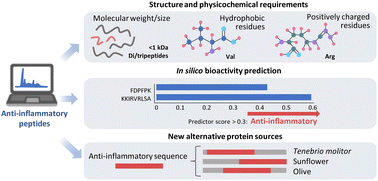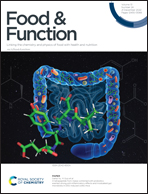Peptides and protein hydrolysates exhibiting anti-inflammatory activity: sources, structural features and modulation mechanisms†
Abstract
Inflammation is the response of the immune system to harmful stimuli such as tissue injury, infection or toxic chemicals, which has the aim of eliminating irritants or pathogenic microorganisms and enhancing tissue repair. Uncontrolled long-lasting acute inflammation can gradually progress to chronic, causing a variety of chronic inflammatory diseases that are usually treated with anti-inflammatory drugs, but most of them are inadequate to control chronic responses and are also associated with adverse side effects. Thus, many efforts are being directed to develop alternative and more selective anti-inflammatory therapies from natural products. One main field of interest is the obtaining of bioactive peptides exhibiting anti-inflammatory activity from sustainable protein sources like edible insects or agroindustry and fishing by-products. This work highlighted the structure–activity relationship of anti-inflammatory peptides. Small peptides with molecular weight under 1 kDa and amino acid chain length between 2 to 20 residues are generally the most active because of the higher probability to be absorbed in the intestine and penetrate into cells when compared with the larger size peptides. The presence of hydrophobic (Val, Ile, Pro) and positively charged (His, Arg, Lys) amino acids is another common occurrence for anti-inflammatory peptides. Interestingly, a high percentage (77%) of these bioactive peptides can be found in alternative sustainable protein sources such as Tenebrio molitor or sunflower, apart from its original protein source. However, not all of these peptides with anti-inflammatory potential in vitro achieve good scores by the in silico bioactivity predictors studied. Therefore, it is essential to implement current bioinformatics tools, in order to complement in vitro experiments with prior prediction of potential bioactive peptides.

- This article is part of the themed collection: Food & Function Review Articles 2022


 Please wait while we load your content...
Please wait while we load your content...